Abstract
Cinnamomum burmannii (Nees & T. Nees) Blume is an endemic tree of up to 20 meters tall that grows in the surrounding forest in the Kerinci regency. Cinnamon is one of the most valuable non-timber forest products (NTFP) harvested from Kerinci. The tree is classified as an NTFP based on criteria set out by a regulation of the Indonesian Ministry of Forestry in 2007. As a result, it must be harvested sustainably. Its massive cultivation has caused deforestation in several areas in Kerinci. The objective of this paper is to assess the environmental impacts of continuous C. burmannii harvesting of the bark by clearcutting the whole tree. Intensive clearcutting, slash, and burn posed a significant threat for (wildlife) biodiversity in the habitat of C. burmannii. The study was performed in collaboration with the Institute for Agricultural Technology of Jambi (BPTP) from October 2018–January 2019. A harvester group in Lempur Mudik village was surveyed through a semi-structured questionnaire, focus group discussions, interviews and direct observations on C. burmannii production methods and their impact on forest conservation. We discuss how young farmers can contribute to forest conservation through sustainable harvesting of cinnamon. We conclude by suggesting leverages for forest conservation and by proposing actions from the local and national governments that should be urgently taken to safeguard wildlife biodiversity in the surrounding forest.
1. Introduction
Cinnamomum burmannii (Nees & T. Nees) Blume is grouped as a non-timber forest product (NTFP) by the Indonesia Ministry of Environment Forestry (MoEF) based on the gazette number 35/1997. Cinnamomum burmannii is an endemic flora species from Indonesia that grows in Indonesia along with the Bukit Barisan mountain range, from Aceh, in North Sumatra, down through west Sumatra, Jambi, Bengkulu, and Lampung [1]. Kerinci regency, Jambi province has three districts that produce high-volume of cinnamon bark (1) Padangaro (2) Kayu Aro (Siulak) and (3) Gunung Raya [2]. From this point forward “cinnamon” will specifically refer to Cinnamomum burmannii (Nees & T. Nees) Blume. The tree is easily recognizable by the reddish colour on the top off its leaves “pucuk merah” and white-grey stem. The tree grows naturally in the secondary forest and land-owned areas surrounding human settlements, which become plantations alongside the primary forest. The cinnamon tree has economic (cash crop) functionality but also ecological purposes. The cinnamon forest is home to an abundance of wildlife such as birds, monkeys bears, and tigers. Many of these species are endemic to a single locality, such as Panthera tigris sondaica (Sumatran tiger) a species which is now believed will become extinct as only up to 400 tigers are reported by WWF living in the surrounding primary forest in South Sumatra, including the Kerinci regency. The tree bark has a unique distinctive aroma that has sweet, warm, and slightly sharp taste. It is commonly used as seasoning, as a spice (ingredient), or in herbal medicine [2]. Kerinci cinnamon with its brand name as koerintji cinnamon is one of the most recognizable and is a buyer’s favorite in the global market. The cinnamon bark from koerintji cinnamon contains a high volatile oil (VO) up to 5.8% and has 92.23% of cinnamaldehyde, which is preferable for the buyers [3]. International companies such as Cassia Co-op, Tripper, Unispices, Daarnhouwer and McCormick are sourcing this commodity directly from the Kerinci regency. As mentioned earlier, to harvest it, harvesters need to cut down (clear-cut) the whole cinnamon tree to remove the outermost layer of bark. Harvester only take the bark of the cinnamon tree and sold it in 4 types of grades, which are KM, KF, KS, and KA. The gate-price is then determined by the grade level; for example, the highest grade is KM and the lowest is KA based on the bark thickness.
Cinnamon bark can be harvested from a cinnamon tree beginning around the tree’s fifth year. To harvest cinnamon bark, harvesters cut down the cinnamon tree and peel-off the outer bark to reach that good layer of inner bark. This inner bark is then peeled off and dried, which causes it to curl up (coil) into cinnamon sticks. The cinnamon trees have two leading roles as a safety net for its survival. First, the bark from the trees plays a vital role as a trading commodity in the economy of farmer households. Second, the trees can maintain and provide a positive influence on the physical environment, especially for protection of wildlife and the erosion of the landscape [4]. The center of production for cinnamon is located in the Kerinci regency, with a size up to 40,632 hectares which is located in 7 districts across the area [5]. The most productive area for cinnamon harvesting is located in the Lempur subdistrict located in Gunung Raya District, Kerinci regency in Jambi province based on the research conducted by Indonesian Spice and Medicinal Crops (Balitro), the Indonesia Ministry of Agriculture in 2013. Gunung Raya District, with a total of 11,224 ha is used as cinnamon agroforest, which can produce up to 14,357 tonnes of dried bark yearly [6]. The bark is harvested starting from the lower stem with a length of about one meter then the tree is felled at the height of 20–30 cm from the ground. A typical harvest can be yield about 300–450 kg of cinnamon bark from one hectare of land, however production can vary greatly depending on the age of the cinnamon tree. Harvesters in Kerinci cultivated the tree using two conventional methods. The first method is by peeling the bark of the tree “santangan” in the local language) without clear-cutting. The peeling of the bark is commonly done in the rainy season (more accessible to peel). Harvesters use a “pisau pangupeh” (a sharp moon shaped knife) to cultivate the bark from the tree and usually start at the bottom of the tree, and to get the highest point, they need to cut down the tree. The second method is clear-cutting, which means cutting the whole tree down and starting to peel from the upper part of the trunk and larger branches. The bark is peeled from the lower part of the trunk in strips about 1 m in length and 7.5–10 cm wide.
The harvesters mostly depend on the income from the cinnamon bark, which requires up to 1–2 ha of land to grow the tree. It has been mentioned by the local government of Kerinci that the cinnamon business involves more than 2216 cinnamon harvesters’ in the Gunung Raya district, part of which is located surrounding the Kerinci Seblat National Park (TNKS). The park is the largest national park in Sumatra (13,791 km2) and is one of the largest protected areas in all of southeast Asia [7]. The cinnamon trees are located at and next to the TNKS, which borders with the land-owned plantations of the harvesters. The threats that are facing in the TNKS regarding deforestation and illegal logging cause wildlife to escape to the nearest liveable areas, such as the cinnamon forest, which becomes a temporary habitat. Evidence and scientific observation have proven that wildlife co-exists in the cinnamon forest in Gunung Raya. The cinnamon forest becomes a buffer-zone between natural forests and villages surrounding the TNKS. Nowadays, extensive harvesting occurs in Kerinci due to the increasing demand for cinnamon in the global market, and in 2017 91,600 tons were exported to foreign countries, which accounted for (40%) of the total global production [8,9]. Cinnamon use as an ingredient and flavoring agent has became worth US$ 107 million in 2017 as a trade commodity and used by 76 countries worldwide [10]. The increasing demand for cinnamon bark has increased the last few years due to the interest from international companies and this becomes the one of the main reasons to harvest in an unsustainable way, which leads to ecological and environmental neglect as mentioned earlier [11].
Cinnamon harvesters’ only cultivate the tree bark and sell it as raw material rather than other parts of the tree, i.e., stem, leaves, and twigs that can be developed into a variety of economically valuable products like essential oils with low volume of harvesting which has higher market price [12]. Since harvesting has become more intensive and widespread, harvesters are sourcing cinnamon bark in conservation forest areas such as the TNKS, where they harvest its bark illegally, and according to interviews conducted with forest rangers only occurs at night [13]. The harvesters leave the stem in the forest to rot after the debarking process, which endangers wildlife from lost natural habitat [14,15]. As is the case in all tropical countries, the biodiversity-rich ecology in Indonesia suffers from exploitation. The challenge is thus to achieve sustainable cinnamon harvesting against the backdrop of growing global cinnamon demand from Indonesia, which has a direct impact on the environment, and also biodiversity loss in its surrounding landscape [16].
Based on the Indonesian Ministry of Environment and Forestry (MoEF) for NTFP, cinnamon is listed as a medicinal plant on the approach of social forestry. Harvester groups/communities should now manage forest landscapes based on a sustainable basis [17]. NTFP sourcing should be environmentally and economically sustainable [18,19]. Managing forests for the production of NTFPs also implies maintaining the biological diversity of all plant and animal species within the forest [20].
However, until now, harvesters are lacking adequate guidelines towards sustainable harvesting, i.e., practices that increase biodiversity conservation, forest management (plant nurturing and replanting), sustainable production, and farmer family livelihoods by conducting intercrop [21]. The research paper has the purpose of characterizing the condition of sustainable harvesting of cinnamon in the Kerinci regency, Indonesia, as one of the largest producers of C. burmannii. We hypothesize that the harvesters preparedness to apply sustainable harvesting, can be one of the solutions for cinnamon forest conservation. To access the global market, harvesters are required to ensure that they practice environmentally sustainable cultivation practices, including replanting.
2. Methodology
2.1. Conceptual Framework
As a result of the research conducted in 2017 that the involvement of the Indonesian government as the primary stakeholder in the cinnamon value chain is necessary to enable the whole enabling environmentall process (Figure 1) [21].

Figure 1.
Conceptual Framework.
Indonesian ministries such the Ministry of Environment and Forestry (MoEF) can support the development and coordination of cinnamon harvesters’ practices to meet sustainable harvesting practices. Based on the MoEF-social forestry platform, forest farmer groups/communities should manage the forest landscape on a sustainable basis, which 1–2 ha in densely populated area (generally for harvesters) or 4–5 ha (generally estates in less densely populated areas). The involvement of the MoEF through social forestry can lead towards greater productivity and the ability to capture a higher value includes methods of harvesting, drying, packaging, research development, education, and training in product marketing in the future. The aim of this research is to analyze to what extent a harvester can develop towards the sustainable harvesting of C. burmannii in the Kerinci Regency, Indonesia. The hypothesis is developed from the theoretical concepts and the conceptual framework, as presented in Figure 1, is explained further below.
- A non-timber forest product (NTFP) product, such as cinnamon, can provide income for smallholder families in Kerinci.
- As mentioned before, a harvester is choosing clearcutting as the best practice to harvest the cinnamon bark. The harvesting is not conducted in the most “sustainable” way, for example, there is no replanting of the cinnamon seeds. To attract harvesters to continue with cinnamon bark harvesting, the MoEF can educate them towards sustainable harvesting.
- This support could result in a better practice from the harvesters because environmental damage and wildlife loss can be prevented. The harvesters can be thought of as upgrading their practice such as certification and, sustainable agroforestry through silviculture. This all could result in increased sustainable harvesting practices.
- However, clearcutting practices are the easiest way to harvest the tree bark. However can be educated by ministries to change the harvesting method.
- This education and technical assistance can have an influence on harvesters in the future. The local policies and economic instruments, such as incentives and subsidies, can bring an opportunity for a harvester to change their practice.
Based on the conceptual framework, a multistakeholder approach should address a better practice of sustainable harvesting. The bottom-up process, with assistance from the Assessment Institute for Agricultural Technology (BPTP) and the Forest Management Unit (KPHP), can educate harvesters to adopt sustainable harvesting practices.
2.2. Study Design
The data used for this research was mainly primary and partly secondary data, semi-structured interviews, and surveys. This research aims at identifying the possibilities for sustainable cinnamon harvesting in the Lempur subdistrict. The main questions that we address include (i) what are the standard practices of cinnamon harvesting in Lempur and (ii) what are the best methods to improve sustainable cinnamon harvesting?
Qualitative data has also been collected through the surveys, but also at the hand of interviews. A qualitative method, using a case-study approach, was used [22]. A complete description and analysis of the research subject were conducted, without limiting the scope of the research and the responses from the harvesters. The research was committed to spending extended time in the field, collecting extensive data for an insider perspective and to answer the research question.
2.3. Research Approach
We used an inductive approach, which began with observation, finding the patterns of harvesting methods, which lead to testing the hypotheses. The primary reason using the inductive approach is based on the small sample of the respondents within the community. However, one weakness of this approach is that it produces generalized conclusions and theory-based observations, in which the reliability of the result needs further research related to the findings [23].
2.4. Data Collection and Methods
We searched for peer-reviewed articles from the beginning of 2018 in 3 free-access bioscience sources databases, i.e., ISI Web of Knowledge, Science Direct, and Google Scholar. The initial search syntax used was “sustainable harvesting,” in combination with “NTFP,” “commercial harvesters,” “harvesting impacts,” “biodiversity,” and “cinnamon.” The keywords were to search for publications focusing on biodiversity and conservation relating to the different methods of harvesting used by traditional harvesters and industrial agroforestry, the effects of harvesting on biodiversity in tropical countries. We tried to identify in several areas of agroforest the harvesting of cinnamon bark cultivation to understand the harvester’s practices.
Then, we performed a field trip to Indonesia in October 2018 to collect information from multiple sources, using face to face interviews, informal meetings, and direct observations. The local research partner guided us through the field research, which gave us vital information to complete the research. Respondents included traditional cinnamon harvesters, cooperatives, and traders in Lempur. Similarly, secondary data were gathered from reports and records of local district officials and other organizations that are relevant to the research findings such as the Kepala Desa (village leader). These methods allowed for a more in-depth exploration of sustainable harvesting and collection of information that facilitated a greater understanding of the constraints and opportunities in the respective contribution in conservation. An informal discussion was conducted to understand standard harvesting practices in the location on 16 October 2018. Some of the participants were invited to the informal discussion, which they had already participated in individual interviews. The participants that participated were divided into two small groups to discuss in-depth the research question about adopting sustainable harvesting and forest conservation.
2.5. Site Description
The field experiment was conducted in one locality (S 02°16′42.8″; E 101°33′40.1″) in the community cinnamon agroforest of Lempur Mudik village, Gunung Raya district, Kerinci regency, Jambi Province, Indonesia (Figure 2). The location of the research site was selected due to the results from the analysis of high volatile oil (VO) and production capacity based on the information given by the research partners (the Indonesian Agency for Agricultural and Research Development). Based on the corresponding exporter in the Netherlands (Unispices Bawaran B.V), the buyers are looking for cinnamon sticks that contain high VO. The higher concentration of VO makes the quality of cinnamon better and has a higher gate-price [20].

Figure 2.
Site Description of the research site in Lempur Mudik [Adjusted by google map].
The cinnamon agroforest in Lempur is capable of producing high-quality cinnamon due to its fertile soil and based on Decree of the Indonesia Ministry of Agriculture NO: 51/KPTS/KB.020/9/2017, concerning the determination of High-Producing Blocks (BPT) and Cinnamon Selected Trees (PIT) in Lempur Mudik, Gunung Raya district as the primary source of superior seeds. The blue marker indicates the that research location was situated in a lowland secondary forest at approximately 1076 metres above sea level. Lempur has a size of 17,560 Ha. The cinnamon agroforest is surrounded by small villages such as Lempur Tengah, Lempur Mudik, Lempur Hilir, Baru Lempur, Manjuto Lempur, Parikan Tengah, Sungai Angat, Kebun Baru, Kebun Lima, Air Mumu, and Masgo. According to local knowledge, Lempur comes from the Kerinci language, which comes from the word “Talempow or Terlumpur”, which later becomes Lempur. Seeing its natural conditions, indeed this area is a highland mud marsh surrounded by hills and mountains.
2.6. Respondent
To gather information about the harvesters’ practices, a field survey was conducted in the Lempur district. For the survey, harvesters were approached by visiting the cinnamon agroforest in Lempur with the guidance of BPTP. This way specific characteristics sustainable harvesting can be measured between the areas. The survey consisted of quantitative and qualitative questions. In addition to the survey, interviews were held at local governmental departments in the city of Sungai Penuh. The purposively selected respondents were affiliated with the Embun Pagi farmers-group, comprising of 170 members. A total of 30 harvesters at the group were selected based on the recommendation given by the head of Embun Pagi (Table 1). The 30 harvesters were actively engaged in practicing organic farming based on the EU organic label.

Table 1.
Harvesters characteristics in the Lempur subdistrict.
The respondents were male and female cinnamon harvesters who are actively involved in the group, who hold a weekly meeting to share price updates, methods, and extra information on cinnamon related activities. The in-depth interviews were carried out with these 30 respondents (n = 30). To answer this research question, the following sub-questions were asked:
- o
- Harvesters’ perception of environmental responsibility and the conservation of natural resources
- o
- Harvesters’ commitment to continuous improvement for sustainable harvesting activities
- o
- Use of appropriate best practices by harvesters
Furthermore, the research needs a broader understanding of harvesters’ perceptions of sustainable harvesting. To gain more information, a group of harvesters was invited on the 16 October 2018 to discuss sustainable harvesting. During the discussion, the research team involved broader stakeholders in the process. Stakeholders from subdistricts such as Kayu Aro, Siulak, and Batang Merangin. The discussion, therefore, brought together stakeholders that were purposively selected to represent “the possibility of upgrading towards sustainable harvesting.” The participants of the discussion were divided into small groups to discuss in-depth the question of sustainability, specifically (1) to identify best practices of bark harvesting and (2) to identify biodiversity loss caused by clear-cutting without replanting. Participants were asked to provide information on how they could increase their productivity and meet the Indonesian sustainability regulations (NTFP Gazette number: p.35 / menhut-ii /2007. The protocol state that “forests are an ecosystem that consists of natural resources which are dominated by trees and natural habitat which cannot be solved from one another.”
2.7. Data Analysis
The data was collected with the surveys at the harvesters’ level about their understanding and perception of sustainable harvesting related to forest conservation. Sustainable harvesting has any effect on global trade as a sustainable product. The data collected with the surveys from the harvesters about sustainable harvesting were compared between the two groups of harvesters from the two areas in Lempur to see their understanding of clearcutting and impact for the environment. For these surveys, the quantitative data from the 30 harvesters were analyzed with Microsoft Excel. The analytical tools that used were a chi-square test for nominal and ordinal variables. The chi-square test was chosen to show the differences in answers between the nominal variables between the two groups during the discussion.
3. Result
According to the interview with BPTP and KPH in January 2019, the harvesting of cinnamon became intensive and more widespread in Kerinci since five years ago. Currently, three aspects are not favorable for the preservation of forests in Lempur mudik, namely (i). better farming practices (ii). Afforestation, and (iii) controlled deforestation. Cinnamon harvesting can have an impact on the degradation of the environment (Figure 3) where soil erosion, reduced soil fertility, critical land loss, and forest loss affects the protection of biodiversity.

Figure 3.
Routine harvesting and peeling of cinnamon bark in Kerinci.
The current situation was identified that harvesters in Lempur, Gunung Raya subdistrict collect as much bark as possible in Lempur and are generally “price takers” with limited bargaining power due to the increasing demand. Depending on a cash crop make the harvesters depending on this commodity, and during the tree growth of 5–7 years, the harvesters are living in a low-income situation that jeopardize their livelihood. During harvest time, which only occurs once every 5–7 years, harvesters use an ax and saw to cut the tree down. Within one day, they can collect up to 600 kg of wet bark, and one tree can provide up to 20 kg. The calculation meets 30 trees that had been cut daily in Lempur, which impacts on natural habitat. Another behavior or stigma of harvester is that when they receive a lower price than their associate, generally they start to cultivate again to get the same price. The mistake occurs again in the process of sun-drying, which they can make a mistake in the water containment of the bark without knowing the water percentage. The situation becomes a cycle that keeps on going, which impacts on overharvesting due to their not-knowing capacity. Harvesters then sell the raw material individually and mostly to collectors without practicing sustainable harvesting. Although cinnamon is an essential commodity for Lempur and the surrounding areas, it is difficult to determine the exact area cultivated since no records were kept in the local statistical office and local government.
The price acts as an incentive to harvest more substantial quantities of cinnamon, so it needs to be addressed through sustainable harvesting interventions. Harvesting of the bark of cinnamon is usually done in the rainy season from September–February, which is intended to skin the tree easily [24]. Most of the trees that were observed in the research location are between 8–25 years, which are ready to harvest. Based on the interviews and questionnaires n = 30), it was elaborated that most of the harvesters’ in Lempur have at least 1 ha of “ladang kulit” (cinnamon agroforest). Since 2015, the Embun Pagi (harvester group in Lempur) has been assisted by the Assessment Institute for Agricultural Technology of Jambi (BPTP) to improve their farming techniques and seedling processes. The cinnamon farmers were previously not organized so they did not make much profit out of cinnamon cultivation, nor out of the sales, let alone the planting of new cinnamon trees. Most of the harvesters in Kerinci were previously not trained, so they did not know how to organize and manage groups, and they have no orientation on how to develop and practice sustainable harvesting more efficiently.
In other areas of the surrounding TNKS, Batang Merangin, a similar integrated approach has been promoted by Rikolto (Belgium based non-profit organization) where the harvesters were previously clear-cutting the slopes of the park, resulting in severe soil erosion. In return for agreeing to use organic and sustainable harvesting practices, harvesters’ are now provided with training, support, and market outreach. Sustainable harvesting is the primary concern for BPTP which can be translated to provide a constant supply of cinnamon bark in Lempur by improved by harvesting methods. According to BPTP, clearcutting is not the appropriate platform for sustainable harvesting, and one of the indicators for harvesters is that they are more adequate in using their knowledge and capacities by interacting with the environment for the better compliance towards sustainable harvesting. Harvesters see the value price is higher when the tree reaches more than 15 years due to quality of the bark increasing with its age (n = 30). Interviewed harvesters consider prioritizing the amount of bark they can peel rather than the environmental impact it has. Peeling requires skilled labor, and the know-how of cinnamon peeling is handed down from generation to generation (n = 30). The clearcutting (“tebang habis”, in the local language) is the easiest way to cultivate the bark when the tree reaches ten years old, and it involves cutting down the whole tree, followed by peeling the bark (Figure 4).

Figure 4.
Process clear-cutting cinnamon tree in Lempur.
After the clearcutting and peeling process, the bark is then scraped with a “pangikih” (blunt knife) to clean it off moss, crust, and cork. It takes a group of men and women to do this activity, which can takes hours until finally finished. The harvesters leave the tree stem in the forest due to its lack of value (Figure 5).

Figure 5.
Clearcutting impact of cinnamon tree in Lempur.
As for the reasons for choosing clearcutting, it depends on different kinds of factors. Based on Figure 6, 22 harvesters had chosen clearcutting due to economic reasons as cinnamon is the primary cash-crop for their livelihood. Clearcutting for the respondent was the most common and economically profitable method of getting the bark. Based on the 25 respondents (n = 30) mentioned that cinnamon is easy to grow (“rumput hutan”, the local language), which does not present any concern for replanting. The increasing gate-price of cinnamon bark is the reasons for 20 respondents to choose to clear cut rather than cultivating by height as can be noticed (Figure 6).
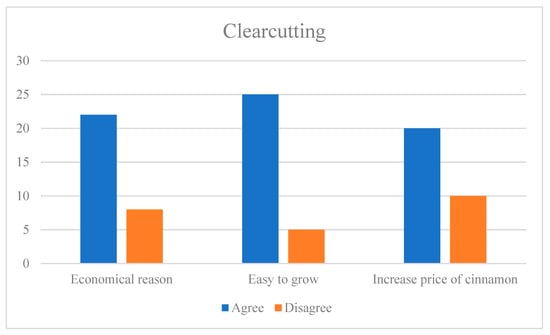
Figure 6.
Reasons for clear-cutting.
The impact of clearcutting in Lempur could have caused the elimination of wildlife species due to soil erosion and tree loss according to the BPTP. The most famous is the northern Sumatran surili monkey (Presbytis melalophos). The monkey is one of many animals that live in cinnamon trees, and some of the forest fauna have also lost their homes and hunting grounds as a result of clearcutting; this is based on the observation that the diversity of animal species decreases from the removal of the cinnamon tree. A harvester is now needing assistance and guidance from those who are surely equipped with sufficient grounds on promoting sustainable harvesting. Eventually, the products that are being produced will meet international standards (certification) of usage of natural resources and even biodiversity. To answer the research question, a second measurement had been conducted to understand harvesters’ views towards sustainable harvesting (Figure 7).
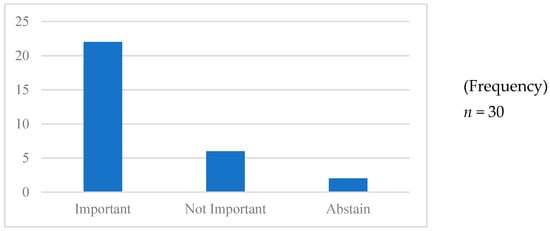
Figure 7.
Farmers’ perception of sustainable cinnamon bark harvesting practices (interview).
The graph shows that 6 of total respondents interviewed (n = 30) have a minimum understanding of sustainable harvesting, which concludes that the adoption of sustainable harvesting practices can have a positive impact on resource conservation, socio-economic status of the community, quality of products and economic returns [25].
The hypothesis of farmers’ preparedness to apply sustainable harvesting, which can be one of the solutions for forest conservation was questioned during the group discussion that was conducted in Lempur and the results of which are shown in Figure 8.
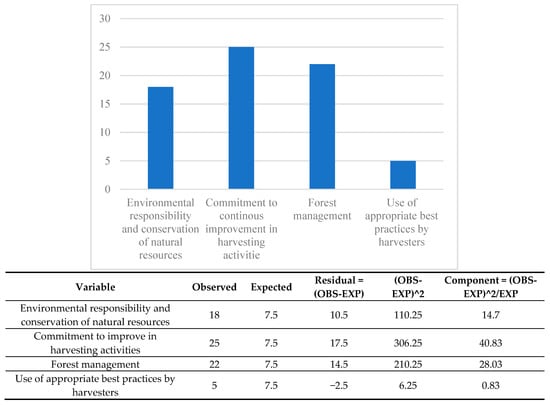
Figure 8.
Chi-square test (n = 30).
Based on the chi-square, twenty-five of the correspondents in the group discussion see the commitment to continuous improvement in harvesting activities as important. On the environmental responsibility and conservation of natural resources, eighteen out of thirty harvesters consider it essential and most of them are the younger generation of harvesters. Forest management ranks as the second most important consideration for sustainable harvesting with twenty-two correspondent. However, five of the correspondent consider clear-cutting as the best practice to get the bark during the harvest. Clearcutting is the easiest way for a farmer to meet the increasing demand, which causes farmers’ to harvest cinnamon on a massive scale and overexploit the agroforest to the extent that natural regeneration is now being hampered, especially in Lempur.
4. Discussion
The causes of unsustainable harvesting in general, are listed by Louis and Nel [26] as (i) increasing commercialization of NTFP, (ii) increasing demand in the local and world markets, (iii) lack of appropriate policies and legislation and/or the failure to enforce them, and (iv) poverty and high unemployment. The shift from subsistence use to commercial trade in spice has led to an increase in the frequency of cinnamon harvested from wild habitats. The young harvesters who took part in the study consider that protecting their forest can bring back was has been lost, such as wild animals due to the massive deforestation in Kerinci regency caused by palm oil and rubber plantation. Elmqvist et al. [27] mentioned that some animals have essential roles in ecosystem processes and organizations, such as pollination, seed dispersal, and herbivory, and the loss of these species has negative consequences for the ecosystem (Figure 9). The consequences of clearcutting are that cinnamon trees can no longer provide shelter for various forest species and other the riches of the forest are lost also. Wildlife, such as the sun-bear (Helarctos malayanus), Sumatera tiger (Panthera tigris sumatrae), The Sumatran surili monkey (Presbytis melalophos melalophos), Malayan tapir (Tapirus indicus), bearcat (Arctictis binturong), and endemic birdlife, such as Schneider’s pitta (Pitta schneideri) are forced to find new habitats (Figure 10). Species such as Treron vernans, live in the surroundings of cinnamon agroforest in Lempur where wildlife used to hunt and eventually live along-side villagers.
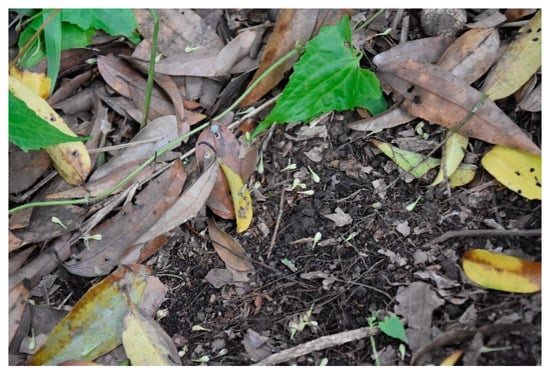
Figure 9.
Insect trap using cinnamon berries made by Treron vernans L (Pink-necked green pigeon).
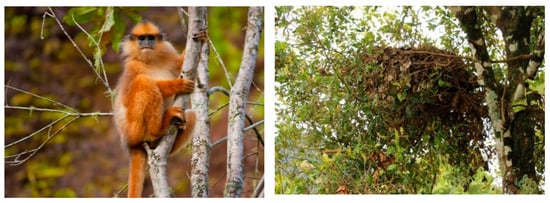
Figure 10.
Wildlife living in the cinnamon trees (left: surili monkey, right: bear nest).
Therefore, farmers should be made aware of the environment (Comm. MoEF, November 2018). The impact of cinnamon overharvesting can have an environmental degradation impact in Lempur. The cinnamon trees grow surrounding the village and also society. Intensive harvesting without replanting can cause rapid forest loss. Forest conservation is therefore threatened with more and more unsustainable practices of harvesting [28]. The situation is more critical to achieving sustainable harvesting. The increasing demand make the situation awkward and harder to achieve sustainability, where farmers are focused on cultivating more cinnamon trees. The sustainable harvesting of NTFPs through adding value to the forest can serve a stimulus to forest management [18,29]. One of the methods that farmers can adjust to in traditional harvesting is to adopt international standards for sustainability to meet global market demands for cinnamon as a premium-product. The international standard has guidelines for farmers’ to conduct farming practice in a more sustainable way, including environmental awareness.
Sustainable harvesting is related to product quality, which can be a significant problem for consumers in Western countries, such as in Europe. European consumers are very selective in choosing products in terms of food, safety, and quality. Consumers in Europe take into account the quality aspects of a product before making a purchasing decision [30]. Cinnamon is consumed throughout Europe and the needs of protocols for market requirements need to be adjusted. The standards and certifications on the non-tariff for specific sectors, which include HACCP, GAP, GMP, ISO norms, health standards, trade fairness, environmental standards and they are all essential to comply with. Certification schemes and initiatives, such as consumer recommendation lists, are influencing consumers choice [31]. Sustainability claims in certification schemes can be divided into four categories [32]:
- Environmental issues (e.g., ecosystems and biodiversity, waste management);
- Labor conditions (e.g., health and safety, human rights in the workplace, including child labor and forced labor);
- Local economic and community benefits (e.g., business ethics, fair-trade, education, social rights);
- Food safety and quality (e.g., traceability, hygienic production, and handling).
However, researchers stress that those supposed sustainable products are sometimes mere marketing claims. Whether consumers differentiate between supposed sustainable marketing claims and proper environmentally-friendly or Fairtrade products that depend upon their sustainability knowledge. Consumers with knowledge about sustainability are supposed to evaluate sustainability claims critically and tend to trust primarily those businesses that show convincing efforts regarding sustainability [33].
In the last decade, cinnamon products have non-tariff concerns to enter directly into the European market due to high standards and technical requirements. Another issue is related to the high cost of obtaining and maintaining standards certificates. Only listed international companies have certificates and standards for the wholesaler, see Table 2 below.

Table 2.
List of certifications owned by processing companies.
Since the beginning of 2019, Embun Pagi had been trading with international buyers through the support of BPTP and they realize the importance of organic certificate for cinnamon production and the need for upgrading to a cooperative to have a legal entity. Working with international buyers made the Embun Pagi group understand the importance of an organic certificate. Organic certification is predominantly used for cultivation operations, but can also be applied to wild collection. While the different organic regulations do have some requirements on ensuring the sustainability of wild crop harvesting. It is also crucial for the group to become cooperative regarding the legal aspects and the ability to trade externally as an independent body following this certification. As explained by the leader of Embun Pagi, being a cooperative will help them to meet the requirements of certified organic companies and also take full advantage of the government’s support policies in promoting the collective economy. Global consumer demand to produce a sustainable product has increased rapidly in the last decade.
The acknowledgment of fair trade, organic agriculture, and sourcing information have all been studied in the context of global value chains to improve productivity [34]. Studies have reported varying examples of the impact of fair trade certification in developing countries. Cinnamon harvesters participation in alternative systems, such as fair trade, can reduce exposure and vulnerability to low commodities prices, meaning that producers have benefited from more price stability [30,35]. However, because fair trade certified products have mostly been found in mainstream markets controlled by multinational companies, it has been suggested that most of the income from the sales of fair trade products is acquired by the consumer countries [36]. A basic economic principle is that exports are components that can affect the economic growth of a region [37,38]. Therefore, Embun Pagi since the beginning of 2019, are currently in progress to meet the sustainable harvesting goals based on the interview (n = 30) and they already follow the organic standards to receive the EU certified of organic label. The support of BPTP is then crucial for the harvesters to overcome unsustainable harvesting and forest conservation. The assistance of education includes (i) encouraging sustainable and non-destructible harvesting (clear-cutting) of NTFPs by creating awareness and imparting training on education for sustainable development; (ii) educate farmers to collect seeds from Cinnamomum burmannii and put them in a nursery; (iii) Teaching how leave the bark uncultivated up to 20 cm from the ground.
In Figure 11, it is shown that trees are not clearcut in the forest which was taught by Tripper, which leads to the sustainability of the forest.
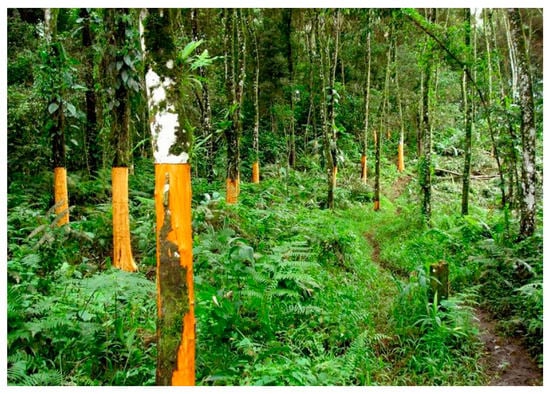
Figure 11.
Cultivating bark by height; Source: Photo courtesy of Tripper, 2017.
In Figure 12, a new approach towards sustainable harvesting has been is conducted by the BPTP since 2015 by creating a cinnamon nursery. Farmers now can plant seeds at the nursery location near the “bidang” (cinnamon agroforest).
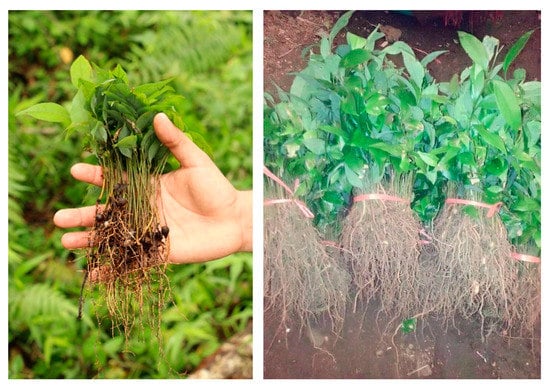
Figure 12.
A breakthrough for the Assessment Institute for Agricultural Technology of Jami (BPTP) in the nursery of Cinnamomum burmannii in Lempur Mudik.
This nursery (Figure 13) is immediately given a canopy to prevent seedling death from direct sunlight. After the age of 6–8 months, the seeds can be transferred to the field. The spacing for cinnamon is 1.5 m × 1.5 m and 2 m × 2 m, while the “tumpeng sari” intercropping process is generally less frequent, i.e., with an area of 3 m × 3 m and 4 m × 4 m.

Figure 13.
Nursery of Cinnamomum burmannii located in Lempur Mudik.
The newest approach by BPTP is by educating the harvester to leave the bark uncultivated 20 cm (Figure 14) up from the tree roots so it can grow new stems from the root stump.
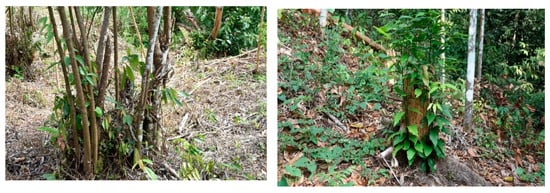
Figure 14.
New stems of cinnamon growing from a root stump.
Based on the education that been thought by BPTP for harvesters’ that they have the potential to develop the sustainable management of cinnamon harvesting in Lempur area. Fact-finding shows that, there is an opportunity for sustainable practices of cinnamon production in the future for cinnamon farmers’ in Lempur. The outcome should deliver an action of long-term programs as a form of environmentally friendly standardization, to compete with other countries in the international market.
5. Conclusions
A conclusion in this research paper is that cinnamon contributes to the livelihood of harvesters to increase the gate-price, but this has an impact on the natural habitat of the wildlife. Therefore, clearcutting practices should be stopped so the environment can benefit. Moreover, the effort towards sustainable harvesting, which had been educated by BPTP is neglected due to the emerging demand for cinnamon bark. The implementation of clear-cutting of the cinnamon tree still occurs, to peel the highest branch for the bark, a farmer cuts down the whole tree. A recommendation in this paper is the need for NTFP policy to act and secure the future of a forest with the triggering of law enforcement within national parks to allow for wildlife to co-exist with the trees by complying new practices of sustainable harvesting. The primary concern is that tree provide shelter, and hunting ground for wildlife in the forest such as sun bears (Helarctos malayanus), leaf monkeys (Presbytis melalophos), grey-headed woodpecker (Picus canus). Sustainable harvesting has other functions, such as reducing the landslides in hilly areas due to the deep roots of the trees in the ground. Primary trees help to reduce flooding in the rainy season and reduce drought in the dry season.
Before BPTP is involved in the cinnamon commodity, cinnamon harvesters in Lempur does not have the applied skills to perform sustainable harvesting. The involvement of local government is necessary to connect with harvesters’ including providing rewards and incentives for harvesters’ that meet the sustainable harvesting practice. Looking ahead it is questionable whether the supply will be able to keep up with the demand if it is without a change in the practice. Several socio-economic factors also contribute to overharvesting of cinnamon trees, such as increasing the demand, unequal commercialization chains [39], economic incentives to extract all available resources without controlling for quality [40]. The most necessary thing to do related to the human and environmental relationship includes components such as: (i) strengthening the capacity of local planning by incorporating conservation into the planning aspects of the activities of farmers, (ii) the rights of rationalization of resources and (iii) the development of the local area towards a sustainable living environment. The understanding between harvesters and buyers’ can facilitate a collaboration that fosters biodiversity conservation through engaging with the younger generation of cinnamon harvesters.
Author Contributions
This research was contributed by several researchers since actualization. conceptualization (S.R.M.); methodology (S.R.M., W.V.); software (S.R.M.); validation (S.R.M., J.H., D.R.A.M.); formal analysis (S.R.M.); investigation (S.R.M., J.H.); resources (S.R.M., D.R.A.M.); data curation (D.R.A.M.); Writing—Original Draft preparation (S.R.M.); Writing—Review and Editing (W.V.); visualization (S.R.M., J.H.); supervision (P.V.D., S.S.); project administration (P.V.D.).
Funding
This research is funded by the Indonesia Endowment Fund for Education (LPDP).
Acknowledgments
The research project on which this paper is based was made possible by an education fund from the Indonesia Endowment Fund for Education (LPDP).
Conflicts of Interest
The authors declare no conflict of interest.
References
- Thangaselvabai, T.; Joshua, J.P.; Jayasekar, M. Cinnamon—The sweet bark spice for flavor and fragrance: A Review. Agric. Rev. 2009, 30, 167–175. [Google Scholar]
- Jaya, A.; Rustiadi, E.; Gonarsyah, I.; Bratakusumah, D.S.; Juanda, B. The cinnamon commodity development effect to regional economic: A case study of Kerinci regency Jambi. Forum Pascasarj. 2009, 32, 67–79. [Google Scholar]
- Direktorat, M. Berita Resmi Indikasi Geografis Seri—A Kayumanis Koerintji Direktorat Jenderal Kekayaan Intelektual, Kemenhumkam—Jakarta, Indonesia, MPIG-K2J, 2015. In Handbook of Koerintji Geographic Indications. 2016. Available online: https://dgip.go.id/images/ki-images/pdf-files/publikasi/publikasi_ig/2016/brig3.pdf (accessed on 4 March 2019).
- Rismunandar, P. FB. In Cinnamon and Production Method; Penebar Swadaya: Jakarta, Indonesia, 2001. [Google Scholar]
- Barceloux, D.G. Medical Toxicology of Natural Substances: Foods, Fungi, Medicinal Herbs, Plants, and Venomous Animals; John Wiley and Sons: Hoboken, NJ, USA, 2008. [Google Scholar]
- Statistics Indonesia. Cinnamon Production. Available online: http://jambi.bps.go.id/index.php/linkTabelStatis/343 (accessed on 4 March 2019).
- Anwar. The Kerinci Seblat Integrated Conservation and Development Project. 1996. Available online: http://siteresources.worldbank.org/INTINDONESIA/FLEG/20171740/Anwar.pdf (accessed on 4 March 2019).
- CBI Product Factsheet. Cinnamon in Europe. 2018. Available online: https://www.cbi.eu/node/1963/pdf/ (accessed on 2 March 2019).
- Tringe Global Trade Premium. Cinnamon Export Data 2017. 2018. Available online: https://www.tridge.com/intelligences/cinnamon/import (accessed on 3 March 2019).
- Thibbotuwawa, M.; Hirimuthugodage, D. Analysis of Cinnamon, Pepper and Cardamom Value Chains in Sri Lanka; Institute of Policy Studies of Sri Lanka: Colombo, Sri Lanka, 2017. [Google Scholar]
- Wagner, W.L.; Herbst, D. Cinnamomum Burmannii (Lauraceae); National Tropical Botanical Garden: Koloa, HI, USA, 2009; Available online: https://ntbg.org/database/plants/detail/cinnamomumburmannii (accessed on 2 March 2019).
- Sidi Menggala, P.; Damme, V. Improving Indonesian Cinnamon (c. burmannii (Nees & t. nees) Blume) Value Chains for Greater Farmers’ Incomes. In IOP Conference Series Earth and Environmental Science; IOP Publishing: Bristol, UK, 2018; Volume 129, p. 012026. [Google Scholar]
- Ardi, H.; Raesi, S.; Evalia, N.A.; Paloma, C. Laporan Riset Rantai Pemasaran Kulit Manis Kerinci; VECO Indonesia & Fakultas Pertanian Universitas Andalas: Padang, Indonesia, 2015. [Google Scholar]
- Burgers, P. Resource Management under Stressed Livelihood Conditions: Changing Livelihoods and Management in the Bufferzone of the Kerinci Seblat National Park; Kerinci District: Sumatra, Indonesia, 2004. [Google Scholar]
- Werner, S. Environmental Knowledge and Resource Management: Sumatra’s Kerinci-Seblat National Park. Ph.D. Thesis, Technische University, Berlin, Germany, 2001. Available online: http://webdoc.sub.gwdg.de/ebook/diss/2003/tu-berlin/diss/2001/werner_silvia.pdf (accessed on 3 March 2019).
- Arifin, B. On the competitiveness and sustainability of the Indonesian agricultural export commodities. ASEAN J. Econ. Manag. Account. 2013, 1, 81–100. [Google Scholar]
- Peraturan Menteri Kehutanan Nomor: P.35/Menhut-II/2007. Hasil Hutan Bukan Kayu–Kayu Manis. Available online: http://ifcc-ksk.org/documents/documents/regulation/P35_2007_HASIL_HUTAN_BUKAN_KAYU.pdf (accessed on 6 March 2019).
- Ros-Tonen, M.A. The Role of Non-Timber Forest Products in Sustainable Tropical Forest Management. Holz als roh-und Werkstoff 2012, 58, 196–201. [Google Scholar] [CrossRef]
- Adrijana Biba, S. The case study as a type of qualitative research. J. Contemp. Educ. Stud. 2013, 64, 28–43. [Google Scholar]
- Collis, J.; Hussey, R. Business Research: A Practical Guide for Undergraduate and Postgraduate Students; Palgrave Macmillan: Hampshire, UK, 2003. [Google Scholar]
- Chen, P.; Sun, J.; Ford, P. Differentiation of the Four Major Species of Cinnamons (C. burmannii, C. verum, C. cassia, and C. loureiroi). J. Agric. Food Chem. 2014, 62, 2516–2521. [Google Scholar] [CrossRef] [PubMed]
- Denzin, N.K.; Lincoln, Y.S. Introduction: The Discipline and Practice of Qualitative Research. In Handbook of Qualitative Research, 3rd ed.; Denzin, N.K., Lincoln, Y.S., Eds.; Sage: Thousand Oaks, CA, USA, 2005. [Google Scholar]
- Feagin, J.; Orum, A.M.; Sjoberg, G. A Case for the Case Study; University of North Carolina Press: Chapel Hill, NC, USA, 1991. [Google Scholar]
- Muhammad, D.R.A.; Dewettinck, K. Cinnamon and its derivatives as a potential ingredient in functional food: A review. Int. J. Food Prop. 2017, 20, 2237–2263. [Google Scholar] [CrossRef]
- Hernández-Barrios, J.C.; Anten, N.P.; Martínez-Ramos, M. Sustainable harvesting of non-timber forest products based on ecological and economic criteria. J. Appl. Ecol. Br. Ecol. Soc. 2015, 52, 389–401. [Google Scholar] [CrossRef]
- Kotze, L.; Nel, J.G. Environmental management: An introduction. In Environmental Management in South Africa, 2nd ed.; Juta and Company Ltd.: Cape Town, South Africa, 2009. [Google Scholar]
- Elmqvist, T. (Ed.) Urbanization, Biodiversity and Ecosystem Services: Challenges and Opportunities: A Global Assessment; Springer: Berlin, Germany, 2003. [Google Scholar]
- FAO. The Financial and Institutional Feasibility of Sustainable Forest Management. 2000. Available online: http://www.fao.org/3/X4107E/X4107E04.htm (accessed on 21 March 2019).
- Belcher, B.; Schreckenberg, K. Commercialization of non-timber forest products: A reality check. Dev. Policy Rev. 2007, 25, 355–377. [Google Scholar] [CrossRef]
- Fridell, G. Fair-Trade Coffee and Commodity Fetishism: The Limits of Market-Driven Social Justice. Hist. Mater. 2007, 15, 79–104. [Google Scholar] [CrossRef]
- Janssen, M.; Hamm, U. Product Labelling in the Market for Organic Food: Consumer Preferences and Willingness-to-Pay for Different Organic Certification Logos. Food Qual. Prefer. 2012, 25, 9–22. [Google Scholar] [CrossRef]
- UNCTAD Annual Report, 2015. Retrieved May 2019. Available online: https://unctad.org/en/PublicationsLibrary/dom2016d1ipub_en.pdf (accessed on 21 March 2019).
- Park, H.; Kim, Y.-K. An empirical test of the triple bottom line of customer-centric sustainability: The case of fast fashion. Int. J. Interdiscip. Res. 2016, 3, 25. [Google Scholar] [CrossRef]
- Bidwell, S.; Murray, W.E.; Overton, J. The Rise of Ethical Value Chains in a Globalising World: An Overview of Fair Trade, Organics and Geographical Indications with an Emphasis on Latin America. In Ethical Value Networks (EVeN) Working Paper Series; Victoria University of Wellington: Wellington, New Zealand, 2015. [Google Scholar]
- Bacon, C. Confronting the coffee crisis: Can fair trade, organic, and speciality coffees reduce small-scale farmer vulnerability in northern Nicaragua. World Dev. 2005, 33, 497–511. [Google Scholar] [CrossRef]
- Johannessen, S.; Wilhite, H. Who Really Benefits from Fairtrade? An Analysis of Value Distribution in Fairtrade Coffee. Globalization 2010, 7, 525–544. [Google Scholar] [CrossRef]
- Mankiw, N.G. Teori Makro Ekonomi. In Edisi Keempat; Erlangga: Jakarta, Indonesia, 2000. [Google Scholar]
- Armstrong, H.; Taylor, J. Regional Economics and Policy, 3rd ed.; Blackwell: Oxford, UK, 2000. [Google Scholar]
- Wilsey, D.; Radachowsky, J. Keeping NTFPs in the forest: Can certification provide an alternative to intensive cultivation? Ethnobot. Res. Appl. 2007, 5, 45–58. [Google Scholar] [CrossRef]
- Crook, C.; Clapp, R.A. Ecosystem structure, economic cycles and market-oriented conservation. Environ. Conserv. 2001, 28, 194–198. [Google Scholar] [CrossRef]
© 2019 by the authors. Licensee MDPI, Basel, Switzerland. This article is an open access article distributed under the terms and conditions of the Creative Commons Attribution (CC BY) license (http://creativecommons.org/licenses/by/4.0/).